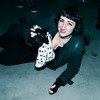
Advertisement
Robert Longo: You’re lucky. You’re also not a guy and maybe if you’re a white guy in America then you can be blamed for everything in the world. It’s an iconic image, for sure. I read Dangerous Nation by Robert Kagan, who addressed the idea of American exceptionalism. American nationalistic ideas are based upon the idea of inalienable rights and freedom for all which is an idea which transcends blood ties and nations. It basically makes American nationalism kind of international. The title of my show, Strike the Sun, is taken from a Captain Ahab quote on his mission to get Moby Dick—which is interesting because Moby Dick is like the genetic code of America. It’s like what A Winter’s Tale was by Heinrich Heine was for Germany.
Advertisement
They say “I love your photographs.” That really freaks me out because people don’t actually look at the things. My drawings are made out of charcoal, which is essentially dust, carbon, one of the primal elements of life. It’s like making a voodoo doll, packing it in with as much as possible.Why did you want to shoot Capitol Hill?
I went to Capitol Hill, photographed it, and learned everything about it—what windows you’re looking into. I want the viewer to be like King Kong, who peeked into the windows of Capitol Hill and see what’s going on in these offices.You created subtle variations in the building’s windows and curtains. What did you do?
There’s a relationship between how many windows are open and closed. There are all sorts of weird shit in there. As a drawing, it’s so extreme. Drawings have always been things in the basement of a museum with low lights, bastard art between painting and sculpture. When I found drawing, I figured out it was something I could exploit and make my own, which was really important. The irony of all this is that I’ve always had a great respect for painting but never had the balls to paint because these guys are heavyweights.What was it like when you visited Capitol Hill?
I couldn’t get very close and I wanted to understand what was happening. I learned what parts of the building were built first and the different sections of the stone color. The image I have is a composite of a bunch of different photographs. The clouds and the sky were meant to have the same perspective as the building itself, like a dolly zoom, where the background changes. I wanted there to be some kind of feeling of movement, that the drawing isn’t static.
Advertisement

This is the back of the Capitol, where they do the inauguration facing the Washington monument. That’s a more historical side of the Capitol, rather than the Greek façade with columns; this is the back. The way it is built has the Senate and the House of Representatives on either side. You know when they are in session by the flag flying. In my drawing, the Senate is in session, the House of Representatives is not, which is how they are in general.Courtesy of the artist, Metro Pictures, and Petzel GalleryCan you tell us more about the piece from John F. Kennedy’s funeral?
I have the drawing of the saddle from John F. Kennedy’s funeral, which has a backwards boot hanging from the horse. This is the actual photograph of the original horse by the original photographer.How did you manage that?
I found him. I first saw that photograph when I was ten years old. I cut school the day JFK was assassinated, I remember watching it on TV. I remember seeing the riderless horse with this backwards boot, it as creepy and it stuck in my mind. The year 1963 was a strong year in my mind; Ad Reinhardt’s black paintings were done in 1963. This is a very American show, obviously. American abstract expressionism represents this postwar euphoria rejecting Europe. It is kind of like high hopes for the future, I guess. It’s a combination of who we think we were and who we are.In your love of black and white pictures, what is your relationship to journalism and storytelling?
I was dyslexic when I was younger, I couldn’t read. I grew up looking at picture magazines, pictures were more important to me than anything else. I remember looking at magazines with Marilyn Monroe on the cover in color, but inside, the kind of stuff that was in black and white was the Vietnam War or the hurricane in Oklahoma. I felt like I was learning that the truth was in black and white.What’s the scoop?
As an artist, our job is to be reporters of what it’s like to be alive now. Back in the 1970s, I was more interested in the art, not so much “the scene.” As an artist, the idea of making money wasn’t even on the menu. I just wanted to make art.Now a lot of artists are fame-obsessed.
I don’t teach, but I have done visiting artist lectures at the graduate program of Columbia University and I can’t believe how some of these guys are. They shouldn’t be artists; they should be lawyers or businessmen. The 1980s got everyone confused, "What do you want to be when you grow up?" Everyone wants to be famous. I wouldn’t want to be a young artist right now. It’s overwhelming.Follow Nadja Sayej on Twitter.
